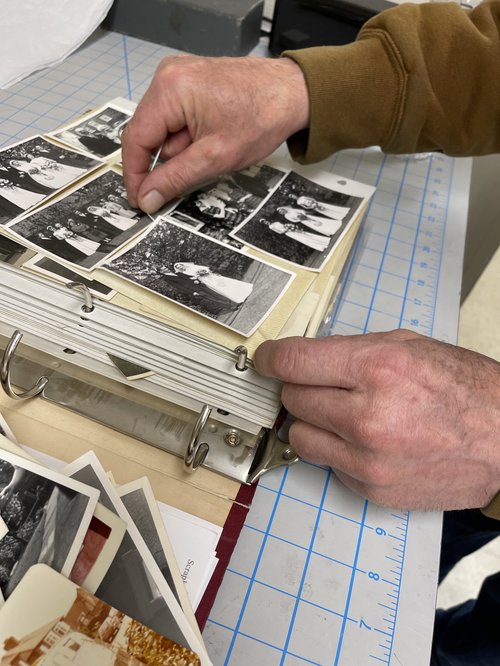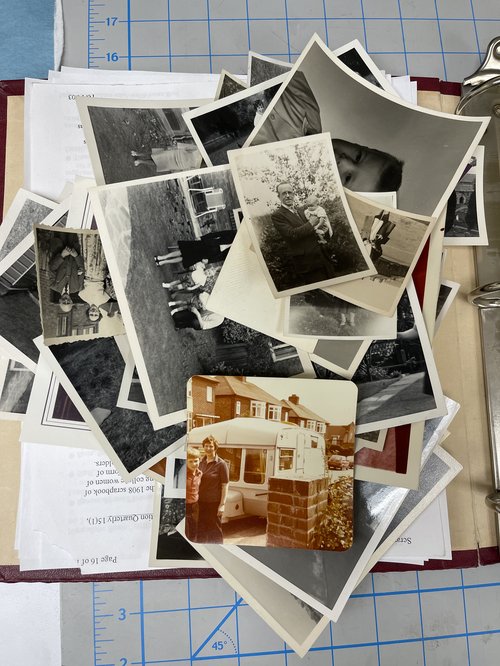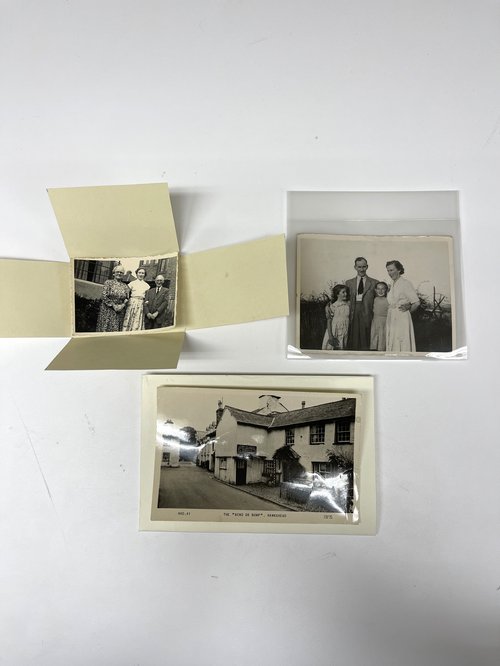Preserving Your Heritage: How to Care for the Family Album

by Anastasia Sopchak, SCRC Conservation Assistant
If your family is anything like mine, your mother has been hoarding every photograph she took in the ‘80’s and ‘90’s in albums that are now starting to fall apart. Pages that were pre-prepared with adhesive are aging and drying out, so the glue is unsticking, and photos are falling out. Even worse is the condition of her mother’s album from the 1940’s with whole pages coming apart, and acidic paper is causing the photos to go yellow or fade. To make sure this family heritage is not lost, and that the photos endure for as long as possible through the generations, we needed to make sure they were stored in a way that ensures they can last as long as possible, or even be digitized someday. The following are some examples of photograph conservation in the Special Collections Research Center (SCRC) Lab that can be done at home, followed by some “Do & Don’ts” and some useful extra resources for keeping your family heritage in good condition.

Family photos in the photo album.
This family album came with sticky pages that had adhesive already and a plastic sheet cover. Over time the adhesive has dried out, releasing the edges of the photos and allowing them to curl. The pages were also not acid free and have contributed to the photos discoloring or turning yellow over time. Some photos have detached already and were falling out, while others were still stuck to the harmful paper.

Removing the photos from the album.
To remove the photos that were still stuck to the page, Conservation Librarian David Stokoe used dental floss here to gently encourage the photo to detach from the page.

Pile of loose photos.
Once the photos have been removed from the old album pages, we need to store them using supplies that are acid-free and inert (chemically stable, or wont release any harmful chemicals over time), and won’t affect the photos to accelerate their aging.

Three photos separated on table.
In the Conservation Lab, we use three methods depending on the photograph collection needs. We can use a four-flap envelope (top left), which uses no adhesive and is made from acid-free paper. We can also use an individual plastic sleeve for each photo (top right), which uses a chemically stable plastic like mylar (polyester) or polypropylene. Finally, we can also use individual envelopes that are open at one end and use acid-free paper as well (bottom). When using these be sure that the envelope seam does not run along the front of the photo.
At home, however, it may not be practical to make individual enclosures for each photo. Some other recommended alternatives are to purchase pre-made individual mylar or polypropylene sleeves for the photos, many of which may come in an album page format allowing you to insert the photos and keep the album as a book. It is not recommended to use any pages made from acidic paper or with any adhesives or glues.

Box with photos in sleeves and another box with loose photos.
If you choose to house each photograph in a paper or plastic envelope individually and don’t wish to keep it in an album format, you can stack the photos vertically in a box if it is snug and does not allow them to slump which can cause them to bend and warp. Above is a picture of a box custom made in the lab to house a photograph series after the photos were put into individual sleeves. At home, you don’t necessarily need to make individual compartments, but do make sure that the photos are snug and don’t slump over which can cause them to bend.
After housing the photos however works best for you, you want to make sure to store them in a cool, dry, dark location. The NEDCC (linked below) recommends a first floor living area, such as a closet, since it will have a more stable temperature and humidity than an attic or basement. Photographs are sensitive to light, so if you are intending to display them try to keep them away from windows or direct light sources and store them in a dark area.
To Summarize:
Do’s:
- Acid-free, well-fitting storage
- Store photographs vertically, if possible, in individual envelopes made of acid free paper or inert plastic like mylar or polypropylene, or plastic album sleeves
- Use acid-free tissue paper to cushion objects, or layer between photos if they must be stored horizontally
- Monitor the temperature and humidity of the room: 68 degrees Fahrenheit and 30-40% Relative Humidity are ideal (Caring For Your Treasures, AIC link below)
- Store photographs in a well-fitting box in a cool, dark, and dry area of the house, like a first-floor closet shelf
Don’ts
- Store near a radiator or window; avoid heat, cold and sunlight
- Use scotch tape, staples, paperclips, rubber bands, or other office supplies that will degrade and damage the items over time. Remove these if already present.
Further Resources:
- Preserving Private and Family Collections- Photographs guide from the NEDCC https://www.nedcc.org/free-resources/preserving-private-and-family-collections/caring-for-private-and-family-collections
- Caring for Your Treasures- Photographs pamphlet from the AIC https://f9f7df2c79cc13143598-609f7062990e04dd7dd5b501c851683c.ssl.cf2.rackcdn.com/aichaw_c8362185071923e160aef031f10ba3e2.pdf
- Preservation Self-Assessment Program Guides (all material types) from the University of Illinois at Champagne-Urbana https://psap.library.illinois.edu/collection-id-guide#audiovisual
